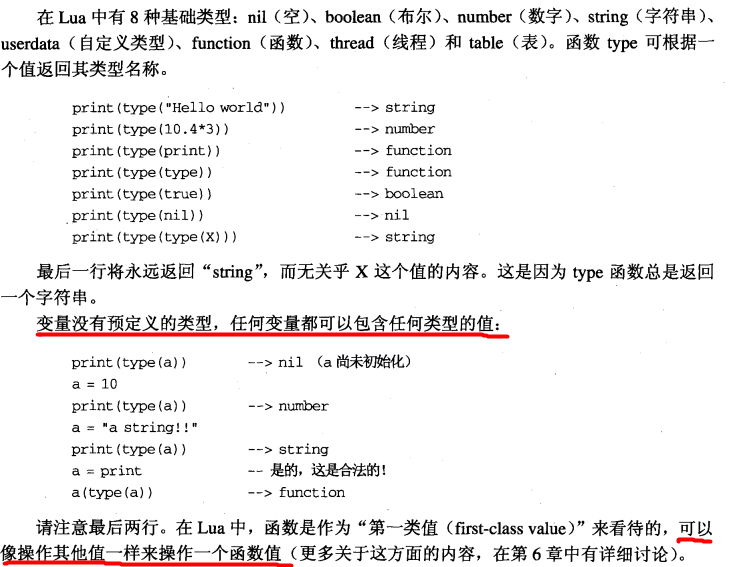CONTENTS
备注:
1 本笔记只记录了LUA的一小部分内容,对于LUA的描述并不全面,以后随用随增加吧。
2 本笔记参考《Lua程序设计 第二版》,截图和代码属于原作者所有。
3 作者初学LUA,经验和能力有限,笔记可能有错误,还请各位路过的大牛们给予指点。
注释:
-- this is commment --[[ this is commment --]] 注意这里的=的数目需要相等 --[==[ this is commment --]==]
变量:
访问未定义变量返回nil。
print(x); -->输出nil x = 10; print(x); -->输出10 x = nil;
类型:

关于bool值:

字符串:
LUA的字符串是不可变的值,LUA修改字符串会创建一个新的字符串。
LUA能够高效的处理长字符串。
关于单双引号,以下代码均可正确输出:
str = "Hello World"; print(str); str = 'Hello World'; print(str); str = 'Hello "test" World'; print(str); str = "Hello 'test' World"; print(str); str = "Hello 'test1' \"test2\" World"; print(str); str = 'Hello \'test1\' "test2" World'; print(str); str = "Hello \'test1\' \"test2\" World"; print(str); str = 'Hello \'test1\' \"test2\" World'; print(str);
输出一段字符串,这里会精确的输出里面的所有内容,忽略其中的转义序列:
str = [[ aa; bb; "test1"; 'test2'; \"test1\"; \'test1\'; ]]; print(str);
输出为:
aa; bb; "test1"; 'test2'; \"test1\"; \'test1\';
输出一段含有[[]]的字符串:

str = [===[ --this is commment1 --[[ this is commment2 --]] [[ ]] [=[ ]=] ]===]; print(str);
输出:
--this is commment1 --[[ this is commment2 --]] [[ ]] [=[ ]=]
字符串操作:
..:字符串连接符
#:获取字符串长度操作符
str = "Hello World"; print(str .. " length:" .. #str); -->输出 Hello World length:11
发表评论